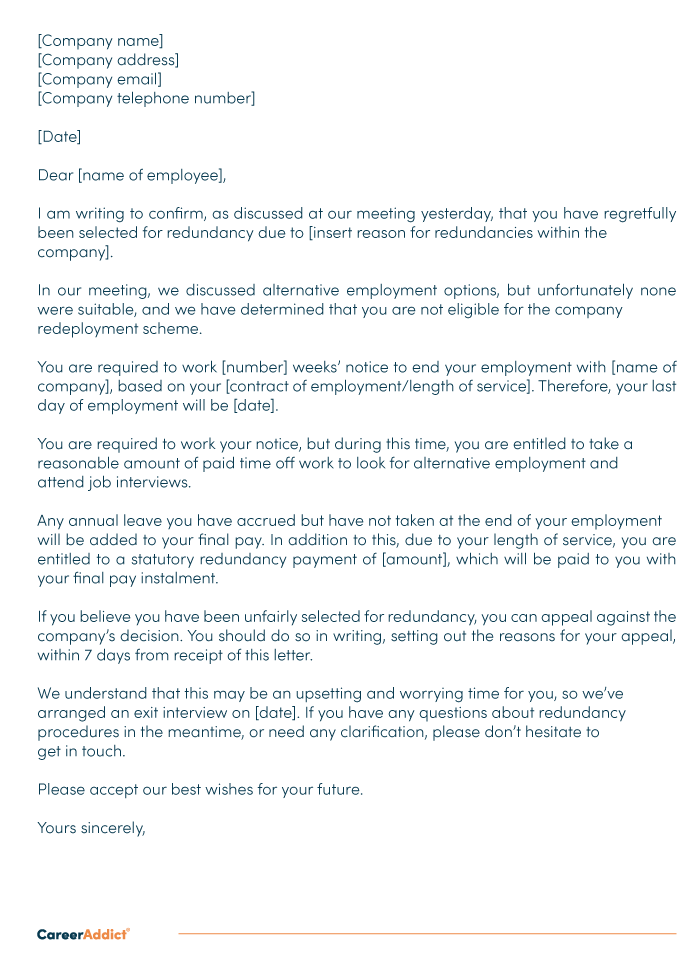If a Company Goes Bust Who Pays Redundancy? Lawful Insights for UK Worker
If a Company Goes Bust Who Pays Redundancy? Lawful Insights for UK Worker
Blog Article
Checking Out the Operational Characteristics of Firm Redundancy and Its Long-Term Sustainability

Redundancy Strategies for Organization Continuity
In order to guarantee nonstop operations, services have to execute efficient redundancy techniques for organization continuity. Redundancy in this context refers to the replication of important parts or functions within a system to mitigate the influence of prospective failings. By including redundancy strategies, organizations can boost their resilience against interruptions brought on by numerous elements such as all-natural calamities, equipment failures, or cyber-attacks.
One common redundancy method is the execution of back-up systems and data storage space solutions. This entails creating matches of necessary information and systems that can be turned on in instance of a key system failure. Additionally, organizations can establish redundant interaction channels and source of power to preserve connection and procedures during unforeseen events.
Moreover, cross-training employees to perform multiple functions within the business can act as a useful redundancy method. If vital employees are unavailable due to health problem or other factors, this ensures that important tasks can still be lugged out even. In general, efficient redundancy techniques are important for companies to maintain operational connection and lessen the impact of possible disturbances.
Effect of Redundancy on Organizational Strength
Provided the essential duty redundancy methods play in making sure business continuity, discovering the effect of redundancy on organizational resilience ends up being vital for understanding the all natural operational dynamics of a firm. Organizational strength refers to an entity's capability to adapt to interruptions, recover from setbacks, and change when essential while preserving core functions. Redundancy, when tactically implemented, can considerably add to improving a company's resilience when faced with unexpected obstacles. By having backup systems, personnel, or procedures in position, companies can much better endure shocks and proceed procedures with marginal disturbance.
Additionally, redundancy can strengthen staff member morale and confidence, knowing that there are contingency plans in place to resolve unforeseen situations. This sense of protection can result in enhanced efficiency and a more positive job environment. Additionally, redundancy can cultivate technology and creative thinking within an organization as workers feel empowered to take computed dangers, recognizing that there is a safeguard to sustain them in situation of failure. Generally, the effect of redundancy on organizational resilience is extensive, forming the lasting sustainability and success of a firm.
Stabilizing Effectiveness and Adaptability in Redundancy
Attaining a harmonious equilibrium in between operational efficiency and adaptive adaptability is an essential challenge in the critical deployment of redundancy within organizations. Reliable operations are crucial for preserving performance and cost-effectiveness, making sure that resources are made use of optimally. Nevertheless, excessive focus on efficiency alone can check out here cause rigidity, making it tough for companies to adapt to unpredicted modifications or obstacles. On the other hand, adaptability enables companies to respond nimbly to progressing circumstances, promoting innovation and durability. Yet, excessive flexibility without a solid operational structure can cause inefficiencies and variance.
To balance performance and adaptability in redundancy preparation, organizations must carefully evaluate their operational demands, market characteristics, and tactical goals. Inevitably, locating the ideal equilibrium in between performance and adaptability is essential for constructing a sustainable and resistant company in the face of uncertainty.
Long-Term Sustainability With Redundancy Planning
To ensure long-lasting practicality and security, organizations have to tactically straighten their redundancy planning with lasting sustainability objectives, therefore harmonizing functional efficiency with flexible versatility. Long-lasting sustainability through redundancy preparation entails even more than just temporary cost-cutting actions. It needs an extensive strategic technique that anticipates future difficulties and possibilities. Companies must view redundancy not as a reactive remedy to instant issues yet as a positive look at this now approach for long-term success. By integrating redundancy preparation with sustainability goals, companies can develop a resilient framework that can hold up against different market variations and inner changes.

Positive Steps for Lasting Company Workflow
Exactly how can firms proactively enhance their functional sustainability for lasting success? Implementing positive procedures is essential for firms intending to ensure sustainable operations. One crucial technique is to invest in modern technology and innovation to streamline processes, reduce waste, and remain affordable in the marketplace. Adopting sustainable methods such as lowering energy consumption, reducing carbon footprint, and optimizing source application can not just profit the setting yet also cause cost financial savings over time.
Moreover, cultivating a society of constant enhancement and learning within the organization can boost flexibility to altering market conditions and client demands. Urging staff member involvement in decision-making processes and giving chances for expert development can enhance spirits, productivity, and overall performance. Developing clear goals, keeping track of key efficiency indications, and regularly reviewing development are vital parts of positive sustainability administration.
Collaborating with vendors, customers, and various other stakeholders to advertise sustainable More Info techniques throughout the supply chain can produce a surge impact of favorable impact - redundancy pay if company goes bust. By taking positive steps in the direction of functional sustainability, firms can build strength, drive advancement, and secure their long-lasting success in an ever-evolving business landscape
Final Thought

In the world of organizational monitoring, the critical release of company redundancy stands as a pivotal yet complex practice that demands a delicate balance in between operational effectiveness and long-term stability. By dissecting the functional dynamics that underpin firm redundancy and assessing its more comprehensive ramifications for business durability and adaptability, a nuanced understanding of exactly how redundancy approaches can shape the future trajectory of a company begins to unravel.Given the important role redundancy methods play in guaranteeing company connection, exploring the effect of redundancy on business resilience becomes important for understanding the all natural functional characteristics of a firm. On the whole, the influence of redundancy on organizational strength is extensive, shaping the lasting sustainability and success of a firm.
In conclusion, comprehending the functional characteristics of business redundancy is essential for making sure lasting sustainability.
Report this page